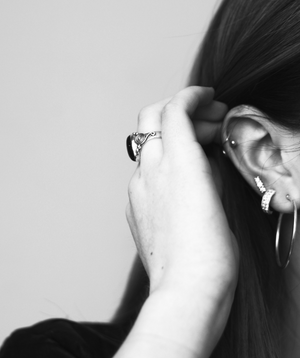
Top 10 most painful piercings
What are the topmost painful piercings? People want to know how painful piercings generally are for various reasons. For some, having a needle piercing through their flesh gives them anxiety. For another, they’d want to know if the pain is worthwhile for whatever piercing they wish to get. In short, people want to be psychologically prepared to know how much pain they’d feel.
There are tons of forums that give a rating of each type of piercing. We’ve taken these and tried to quantify them so we can give you a rounded idea of how much pain you’re likely to be in. Therefore, having one of the specified body parts listed below pierced may or may not be a painful experience for you, and it may hurt more or less than other procedures such as tattoos.
1. Genital Piercing
The genitals are the most sensitive ears of our bodies, so no one needs to convince you that it’ll be the most painful piercing you can ever get. A 9/10 would be a modest scale.
Before you get it, you need to be sure of the type you want, given there are about eight different piercings that men and women can get individually.
The silver lining for these piercings is their healing time. It takes about four to six weeks to heal and six months, depending on your aftercare.
2. Nipple Piercing
Your nipples are one of the most sensitive parts of your body. They have a lot of nerve endings, hence why getting one or both of them pierced will hurt. Many people say that this is one of the most painful piercings that they have gotten.

3. Anti-tragus Piercing
The anti-tragus piercing is done in the other cartilage area opposite the ear canal, not to be confused with the tragus.
The piercing doesn’t last a short time either; the procedure takes about 5-10 seconds, half of it when the needle goes through. The pain levels during this time are a strong 8/10.
Given that it’s cartilage, it will take about eight to 16 months to heal, which is the longest healing time for any piercing on this list. It’s advised that you don’t pierce both sides simultaneously and not to sleep on the side with the piercing because it’ll be super sensitive.

4. Dermal Anchor
A dermal anchor is a petite piercing that sits on the flat surface of your skin. There are no entry and exit spots. The piercer has to remove a small chunk of skin (usually with a dermal punch rather than a needle) to embed the anchor within the body.
Still, if you choose to get this piercing in an area where the skin is taut and doesn’t have a lot of nerve endings, the pain will be minimized.

5. Industrial Piercing
The industrial piercing is unique because it goes through two parts of the ear to make up one very unique-looking piercing. Unfortunately, this comes at a cost, as two piercing holes mean two short and sharp bouts of pain.
Like all other cartilage piercings, the needle has to go through tough tissue, meaning the pressure can feel quite heavy as the needle is pushed through.

6. Daith Piercing
Another area that’s bound to have you feeling quite a bit of pain is the daith area of the ear.
For the longest time, it has been said that perforating the outer cartilage that’s at the center part of the ear can help alleviate migraines.
Whether you’re doing it for medical purposes or beauty, it’s vital to know that the pain levels stand at 6/10. Given the minimal blood flow to the area, you’ll find that it can take up to 12 months to heal, though four months is a more optimistic period.

7. Septum Piercing
If you’re going for a bull ring, you have to be aware that you’ll feel a pain level of about 6/10.
Another thing to note is that you will feel some pain and discomfort that fades away as the healing continues in the first few days.
Those who opt for larger jewelry will be sore for longer too. The healing time is about six to eight months, of which, if the area is recovering well, you can change your jewelry after two months. Be sure to practice proper aftercare.

8. Conch Piercing
With this piercing, the needle has to be pushed through the outer shell of ear cartilage, meaning that the pain can be pretty sharp and intense. Remember, though, that it’s only a few seconds of pain for a lifetime of piercing.

9. Rook Piercing
The rook is a piercing done above where the tragus. Given how small and thick the area is, you can expect to feel pain levels of 6/10 or more depending on your pain threshold.
The healing time is about three to six months.

10. Helix Piercing
The helix piercing is placed in the cartilage groove of the upper ear. While some of the other piercings in this list probably have a bit more bite. This one can still pinch fairly badly due to the tough, stiff cartilage that the needle has to pass through. However, it’ll be over in a flash, and you’ll have forgotten all about it by the time you leave the shop.

How Long Do Piercings Hurt For?
The initial piercing won’t hurt for very long at all. You are likely to experience an instant feeling of pressure and maybe a few minutes of pain. Although, of course, this will largely depend on the location of your piercing. For example, a tragus piercing will hurt more than an ear lobe piercing, as it has to pass through thick cartilage, therefore taking longer to pierce and incurring more pressure.
However, you can expect there to be some soreness after the piercing. This part can drag on for much longer. Yet, the discomfort you encounter is not completely out of your hands. You play an important part in how quickly you heal. If you take care of your new piercing and follow your aftercare instructions to the tee, you will end any suffering at a much faster rate.
According to most piercing professionals, a good guideline is that the soreness should start to deplete after around a week. Unless it’s in a spot where it’s constantly irritated, like your lip or nose, or except if you keep knocking it, such as during sports.



Leave a comment